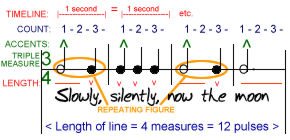
Back Metrum (Musik) ALS Метр (музыка) Byelorussian Размерност (музика) Bulgarian Metre (música) Catalan Metrum (hudba) Czech Taktart Danish Metrum (Musik) German Μέτρο (μουσική) Greek Mezuro (muziko) Esperanto Métrica (música) Spanish

In music, metre (British spelling) or meter (American spelling) refers to regularly recurring patterns and accents such as bars and beats. Unlike rhythm, metric onsets are not necessarily sounded, but are nevertheless implied by the performer (or performers) and expected by the listener.[not verified in body]
A variety of systems exist throughout the world for organising and playing metrical music, such as the Indian system of tala and similar systems in Arabic and African music.
Western music inherited the concept of metre from poetry,[1][2] where it denotes the number of lines in a verse, the number of syllables in each line, and the arrangement of those syllables as long or short, accented or unaccented.[1][2] The first coherent system of rhythmic notation in modern Western music was based on rhythmic modes derived from the basic types of metrical unit in the quantitative metre of classical ancient Greek and Latin poetry.[3]
Later music for dances such as the pavane and galliard consisted of musical phrases to accompany a fixed sequence of basic steps with a defined tempo and time signature. The English word "measure", originally an exact or just amount of time, came to denote either a poetic rhythm, a bar of music, or else an entire melodic verse or dance[4] involving sequences of notes, words, or movements that may last four, eight or sixteen bars.[citation needed]
Metre is related to and distinguished from pulse, rhythm (grouping), and beats:
Meter is the measurement of the number of pulses between more or less regularly recurring accents. Therefore, in order for meter to exist, some of the pulses in a series must be accented—marked for consciousness—relative to others. When pulses are thus counted within a metric context, they are referred to as beats.[5]
- ^ a b Scholes 1977.
- ^ a b Latham 2002b.
- ^ Hoppin 1978, 221.
- ^ Merriam-Webster 2015.
- ^ Cooper & Meyer 1960, p. 3.
© MMXXIII Rich X Search. We shall prevail. All rights reserved. Rich X Search